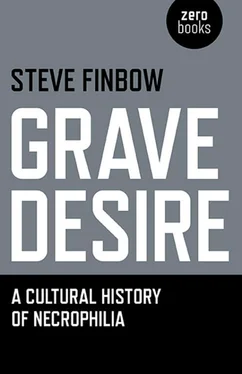Initially, sexologists considered necrophilia a form of sadism, yet Bertrand could inflict no pain on the bodies. Indeed, the amount of pain he went through getting to the corpse or escaping the guards and dogs, made the savage lust his own personal form of necrophilia—necromasochism. Often necrophiles become so through rejection by the opposite sex, but Bertrand had intercourse with living women in the different towns he visited with the army; apparently a good lover, women vowed to marry him. [118] For details of Bertrand’s crimes and case, see Dr Alexis Épaulard, Vampirisme, Nécrophilie, Nécrosadisme, Nécrophagie (Lyons, 1901).
Despite this, every two weeks or so, Bertrand would suffer from intense headaches and become obsessed with a desire for violence and violation, despite the weather, icy waters, frozen or baked earth, guns and booby traps. The necromasochism flipped into necrosadism as a means to enhance the sexual thrill, mutilation as foreplay. Epaulard quotes from Marchal de Calvi’s interview where Bertrand confessed, ‘I have always loved women madly; I have permitted no one to insult them in my presence. I have everywhere had young and charming women as mistresses, whom I have completely satisfied and who have yielded very willingly to me. As proof of this, some, although of rich and distinguished family, have wanted to follow me. I have never touched a married woman. Indecent talk has always offended me. I always tried to bring the conversation to another channel, when such a theme was broached in my presence. I was brought up strictly religious; I have always cared for religion and defended it, but without fanaticism.’
In the late nineteenth century, the Socialist criminologist Enrico Ferri stated ‘Again, there are the necrophiles, like Sergeant Bertrand, Verzeni, Menesclou, and very probably the undetected “Jack the Ripper” of London, who are tainted with a form of sexual psychopathy. Yet again there are such as are tainted with hereditary madness, and especially the epileptics and epileptoids, who may also be assigned to the class of born criminals, according to the plausible hypothesis of Lombroso as to the fundamental identity of congenital criminality, moral madness, and epilepsy. I have always found in my own experience that outrageous murders, not to be explained according to the ordinary psychology of criminals, are accompanied by psychical epilepsy, or larvea.’ [119] Enrico Ferri, Criminal Sociology (1899) available from http://www.gutenberg.org/ebooks/477
Sexual psychopaths and sadistic killers do not always become necrophiles, nor do they all mutilate corpses, but some are only able to experience orgasm at the point of another’s death, during the act of murder or attempted murder—the death of their victims at the point of the killer’s orgasm make them necrophiles by projection. If the authorities mythologized Sergeant Bertrand as the Vampire of Montparnasse, 80 years later and 250 miles from Paris, the German police, in order to comprehend the perpetrator of a spate of vicious sex murders, searched for a man the newspapers were calling the Vampire of Düsseldorf. [120] Details of the lives and crimes of Kürten, Haarmann, Grossmann, and Denke, are from various sources, my descriptions should be considered an amalgamation of available texts, including: Theodor Lessing, Karl Berg, George Godwin, Monsters of Weimar: The Stories of Fritz Haarmann and Peter Kurten, trans. Mo Croasdale (London, 1993); Maria Tatar, Lustmord: Sexual Murder in Weimar Germany (Princeton, 1997); Katherine Ramsland, The Mind of a Murderer: Privileged Access to the Demons That Drive Extreme (Santa Barbara, 2011). Websites: Violence http://www.trutv.com/library/crime/serial_killers/history/kurten/index_1.html , http://www.trutv.com/library/crime/serial_killers/history/haarman/index_1.html , and relevant Wikipedia pages.
Born on 26 May 1883 in the Mülheim district of Köln (Cologne), Peter Kürten spent his poverty-stricken childhood in a one-roomed apartment with thirteen younger brothers and sisters. His alcoholic and sexiopathic father subjected the family to violence and his mother and sisters to rape and attempted rape. The children witnessed their father’s violent sexual assaults and incestuous intercourse with his thirteen-year-old daughter and these events—plus his father’s incarceration for attempted incest—fuelled Peter’s sadistic childhood fantasies. As in many cases of serial murder and necrophilia, Peter began his career of depravity by inflicting violence and sex on animals. These were all mechanisms of defamiliarization.
A dogcatcher lived in the Kürten house, and the man taught Peter how to torture dogs and showed him how to sexually excite them. In this, Peter transferred his father’s sexual violence on to strays that roamed the fortified German city, enlisting the brutal dogcatcher as his father figure. At the age of ten, while boating on the Rhine, Peter drowned another boy and attempted to drown yet another who came to his friend’s aid. As he moved into puberty, the sexual manipulation and torture of dogs and the thrill he felt whilst drowning the boy developed into oricide and hiricide as he repeatedly stabbed sheep and goats while having intercourse with them.
By the turn of the century, Peter had been arrested and imprisoned for theft on a number of occasions and would spend 24 years of his life in prison mostly in Düsseldorf. In 1899, he met a prostitute who allowed him to explore his sadistic side, and he now had a human outlet for his sexual fantasies, her masochism fuelling his violent lust.
Published in the same year that Peter met his masochistic partner, Octave Mirbeau’s Le Jardin des supplices (The Torture Garden) hints at the reasoning Kürten used to justify the escalation of his violent lust to sexual murder. ‘You’re obliged to pretend respect for people and institutions you think absurd. You live attached in a cowardly fashion to moral and social conventions you despise, condemn, and know lack all foundation. It is that permanent contradiction between your ideas and desires and all the dead formalities and vain pretences of your civilization which makes you sad, troubled and unbalanced. In that intolerable conflict you lose all joy of life and all feeling of personality, because at every moment they suppress and restrain and check the free play of your powers. That’s the poisoned and mortal wound of the civilized world.’ [121] Octave Mirbeau, The Torture Garden, trans. Alvah Bessie (London, 2008), p. 83.
The German industrial revolution had swelled the population of Düsseldorf and increased the alienation of its citizens, after defeat in World War I and the occupation by French and British armies, itinerant workers, beggars, and thieves roamed the cities—perfect for any would-be serial killer. While in prison, Peter had elaborated and perfected his unreal universe, his antihuman philosophy. In the introduction to The Torture Garden, Tom McCarthy writes, ‘For the idealist Hegel, the material world is there to be abstracted by the philosopher or artist into thought, into pure, sublimated concept. Hegel’s most famous commentator, Kojève, describes this sublimating process as a form of murder. It is hard not to hear an echo (or, again, pre-echo) of this description in the conversations of Mirbeau’s philosophers, poets and moralists who talk of “backs on the street which cry out for the knife” or his explorer who envisages a bullet “which will annihilate what it hits, leaving nothing.”’
Kürten’s perversity meant annihilation of the other, the event of murder forming a complete absence of person, a negative humanity; he would transgress prison law in order to be placed in solitary confinement, and his detachment from others meant he could fantasize without the need to socialize. Kürten killed men, women, children, and animals—to Peter, every back cried out for a knife, everything existed to be annihilated, to be completely destroyed. Kürten had no understanding of his Gattungswesen (social-being), his life embodied Marx’s theories of alienation, ‘The class of the proletariat feels annihilated, this means that they cease to exist in estrangement; it sees in it its own powerlessness and the reality of an inhuman existence. It is, to use an expression of Hegel, in its abasement the indignation at that abasement, an indignation to which it is necessarily driven by the contradiction between its human nature and its condition of life, which is the outright, resolute and comprehensive negation of that nature. Within this antithesis the private property-owner is therefore the conservative side, the proletarian the destructive side. From the former arises the action of preserving the antithesis, from the latter the action of annihilating it.’ [122] Karl Marx and Friedrich Engels, ‘The Holy Family,’ Complete Works Vol. 4, trans. Richard Dixon and Clement Dutts, first published 1845. Available from http://www.marxists.org/archive/marx/works/1845/holy-family/index.htm
Читать дальше












